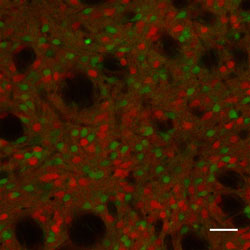
By now, you might have discovered that taming your sweet tooth as a New Year’s resolution is harder than you think.
New research by Duke University scientists suggests that a habit leaves a lasting mark on specific circuits in the brain, priming us to feed our cravings.
Published online Jan. 21 in the journal Neuron, the research deepens scientists’ understanding of how habits like sugar and other vices manifest in the brain and suggests new strategies for breaking them.
“One day, we may be able to target these circuits in people to help promote habits that we want and kick out those that we don’t want,” said the study’s senior investigator Nicole Calakos, M.D., Ph.D., an associate professor of neurology and neurobiology at the Duke University Medical Center.
Calakos, an expert in the brain’s adaptability, teamed up with Henry Yin, an expert in animal models of habit behavior in Duke’s department of psychology and neuroscience. Both scientists are also members of the Duke Institute for Brain Sciences.
Their groups trained otherwise healthy mice to form sugar habits of varying severity, a process that entailed pressing a lever to receive tiny sweets. The animals that became hooked kept pressing the lever even after the treats were removed.
The researchers then compared the brains of mice that had formed a habit to the ones that didn’t. In particular, the team studied electrical activity in the basal ganglia, a complex network of brain areas that controls motor actions and compulsive behaviors, including drug addiction.
In the basal ganglia, two main types of paths carry opposing messages: One carries a ‘go’ signal which spurs an action, the other a ‘stop’ signal.
Experiments by Duke neurobiology graduate student Justin O’Hare found that the stop and go pathways were both more active in the sugar-habit mice. O’Hare said he didn’t expect to see the stop signal equally ramped up in the habit brains, because it has been traditionally viewed as the factor that helps prevent a behavior.
The team also discovered a change in the timing of activation in the two pathways. In mice that had formed a habit, the go pathway turned on before the stop pathway. In non-habit brains, the stop signal preceded the go.
These changes in the brain circuitry were so long-lasting and obvious that it was possible for the group to predict which mice had formed a habit just by looking at isolated pieces of their brains in a petri dish.
Scientists have previously noted that these opposing basal ganglia pathways seem to be in a race, though no one has shown that a habit gives the go pathway a head start. O’Hare said that’s because the go and stop signals had not been studied in the same brain at the same time. But new labeling strategies used by the Duke scientists allowed researchers to measure activity across dozens of neurons in both pathways simultaneously, in the same animal.
“The go pathway’s head start makes sense,” said Calakos. “It could prime the animal to be more likely to engage in the behavior.” The researchers are testing this idea, as well as investigating how the rearrangements in activity occur in the first place.
Interestingly, the group observed that changes in go and stop activity occurred across the entire region of the basal ganglia they were studying as opposed to specific subsets of brain cells. O’Hare said this may relate to the observation that an addiction to one thing can make a person more likely to engage in other unhealthy habits or addictions as well.
To see if they could break a habit, the researchers encouraged the mice to change their habit by rewarding them only if they stopped pressing the lever. The mice that were the most successful at quitting had weaker go cells. But how this might translate into help for humans with bad habits is still unclear. Because the basal ganglia is involved in a broad array of functions, it may be tricky to target with medicines.
Calakos said some researchers are beginning to explore the possibility of treating drug addiction using transcranial magnetic stimulation or TMS, a noninvasive technique that uses magnetic pulses to stimulate the brain. “TMS is an inroad to access these circuits in more severe diseases,” she said, in particular targeting the cortex, a brain area that serves as the main input to the basal ganglia.
For more ordinary bad habits “simpler, behavioral strategies many of us try may also tap into similar mechanisms,” Calakos added. “It may be just a matter of figuring out which of them are the most effective.”
Meanwhile, Calakos and her team are studying what distinguishes ordinary habits from the problematic ones that can be seen in conditions like obsessive-compulsive disorder.
Other authors on the study are Kristen Ade, Tatyana Sukharnikova, Stephen D. Van Hooser, and Mark Palmeri.
The study was supported by the National Institutes of Health (R01 NS064577, T32 NS051156, GM008441-23, AA021074) McKnight Foundation, The Brain and Behavior Foundation, and the Ruth K. Broad Foundation.